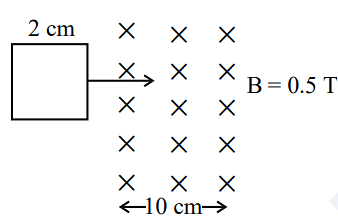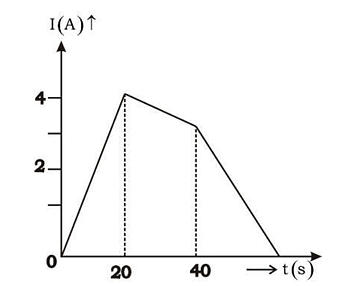A square loop of side 2 cm enters a magnetic field with a constant speed of 2 cm s-1 as shown. The front edge enters the field at t = 0s. Which of the following graph correctly depicts the induced emf in the loop?
( Take clockwise direction positive )

( Take clockwise direction positive )

The Correct Option is C
Approach Solution - 1
Given Information:
Side of square loop, \( l = 2\,cm \)
Speed of loop entering the magnetic field, \( v = 2\,cm/s \)
Magnetic field, \( B \), is uniform and perpendicular to the plane of the loop.
Step-by-Step Explanation:
Step 1: Understanding the problem clearly:
When the loop enters the magnetic field, magnetic flux through the loop changes, inducing an emf according to Faraday’s law of electromagnetic induction.
Step 2: Determine how emf changes with time:
The induced emf is given by Faraday's law as:
\[ E = \frac{d\Phi}{dt} = B \cdot l \cdot v \]
Since \(B\), \(l\), and \(v\) are constant, the induced emf remains constant while the loop is entering or leaving the field. However, the emf changes direction based on whether the loop is entering or leaving the magnetic field.
Step 3: Calculate time intervals clearly:
The loop enters at speed \(2\,cm/s\), and loop side is \(2\,cm\). Thus, the time for the loop to completely enter the field is:
\[ t = \frac{\text{side}}{\text{speed}} = \frac{2\,cm}{2\,cm/s} = 1\,s \]
After fully entering, emf becomes zero since flux remains constant. Then, as the loop exits the field, emf is induced again (but with opposite sign), taking another \(1\,s\) to exit.
Step 4: Describe the induced emf clearly over time:
- From \(t=0\) to \(t=1\,s\), emf is constant positive (clockwise as per given sign convention).
- From \(t=1\,s\) to \(t=2\,s\), the emf is zero (flux is constant).
- From \(t=2\,s\) to \(t=3\,s\), emf is constant negative (opposite direction).
Thus, the correct graph should show a positive constant emf for the first interval, zero emf during the second interval, and negative constant emf in the third interval.
Conclusion:
Option (C) clearly matches this pattern.
Approach Solution -2
The induced emf (\(\varepsilon\)) in the loop can be calculated using Faraday's Law of Induction, which states: \[ \varepsilon = -\dfrac{d\Phi}{dt} \] where \(\Phi\) is the magnetic flux given by: \[ \Phi = B \cdot A \cdot \cos \theta \] where:
\(B\) is the magnetic field,
\(A\) is the area of the loop, and
\(\theta\) is the angle between the magnetic field and the normal to the loop.
Since the magnetic field is perpendicular to the loop (into the plane of the paper), \(\cos \theta = 1\). As the loop enters the magnetic field, the area of the loop within the magnetic field increases. The induced emf is directly proportional to the rate of change of the area exposed to the magnetic field. Given that the loop enters with a constant speed of \(2 \, \text{cm/s}\), the area increases at a constant rate, leading to a linear increase in the induced emf. Once the entire loop is inside the magnetic field, the emf becomes constant because the area in the magnetic field does not change anymore. Thus, the graph of induced emf will show a sharp increase and then become constant.
Thus, the correct graph is (C).
Top Questions on Faradays laws of induction
- The magnetic flux \(\phi\) (in weber) linked with a closed circuit of resistance \(8 \, \Omega\) varies with time (in seconds) as \(\phi = 5t^2 - 36t + 1\). The induced current in the circuit at \(t = 2 \, \text{s}\) is ______ A.
- JEE Main - 2024
- Physics
- Faradays laws of induction
- In a coil, the current changes form –2 A to +2A in 0.2 s and induces an emf of 0.1 V. The self-inductance of the coil is :
- JEE Main - 2024
- Physics
- Faradays laws of induction
- A metallic rod of length 1 m held along east-west direction is allowed to fall down freely. Given horizontal component of earth’s magnetic field BH = 3 × 10-5 T. The emf induced in the rod at an instant t = 2s after it is released is ( Take g = 10 ms-2 )
- KCET - 2023
- Physics
- Faradays laws of induction
- The current following through an inductance coil of self inductance 6 mH at different time instants is as shown. The emf induced between t = 20s and t = 40s is nearly

- KCET - 2021
- Physics
- Faradays laws of induction
- A wheel with $20$ metallic spokes each $1\, m$ long is rotated with a speed of $120\, rpm$ in a plane perpendicular to a magnetic field of $0.4\, G$. The induced emf between the axle and rim of the wheel will be, $(1 G = 10^{-4}\, T)$
- NEET (UG) - 2020
- Physics
- Faradays laws of induction
Questions Asked in KCET exam
- The minimum value of \( 1 - \sin x \) is:
- KCET - 2025
- Inverse Trigonometric Functions
Match List-I with List-II and select the correct option:

- KCET - 2025
- Bond Parameters
- The maximum value of \( z = 3x + 4y \), subject to the constraints \( x + y \leq 40, x + 2y \geq 60 \) and \( x, y \geq 0 \) is:
- KCET - 2025
- Linear Programming Problem
- Given, a current carrying wire of non-uniform cross-section, which of the following is constant throughout the length of the wire?
- KCET - 2025
- Current electricity
- If the number of terms in the binomial expansion of \((2x + 3)^n\) is 22, then the value of \(n\) is:
- KCET - 2025
- Binomial theorem



